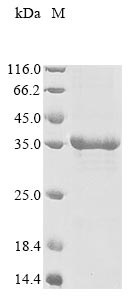Optimize your cancer research endeavors with our superior-quality Recombinant Human LYPD3 protein. Ly6/PLAUR domain-containing protein 3 (LYPD3), also known as C4.4A, has been implicated in various cancer types due to its involvement in cell migration, adhesion, and metastasis. The study of this protein holds potential in uncovering novel cancer therapeutics and understanding the underlying mechanisms of tumor progression.
Our Recombinant Human LYPD3 protein has been expertly produced in E. coli to ensure a dependable and consistent expression system. Covering the full length of the mature protein (31-326 amino acids), this recombinant protein has been meticulously designed to maintain the structural and functional integrity of the native LYPD3. The N-terminal 10xHis-tag enables streamlined purification while preserving the protein's bioactivity. With a purity of greater than 85% as determined by SDS-PAGE, our Recombinant Human LYPD3 protein is the ideal choice to elevate your cancer research endeavors. Choose our high-quality protein for accurate and reliable insights into the role of LYPD3 in cancer development and progression.




